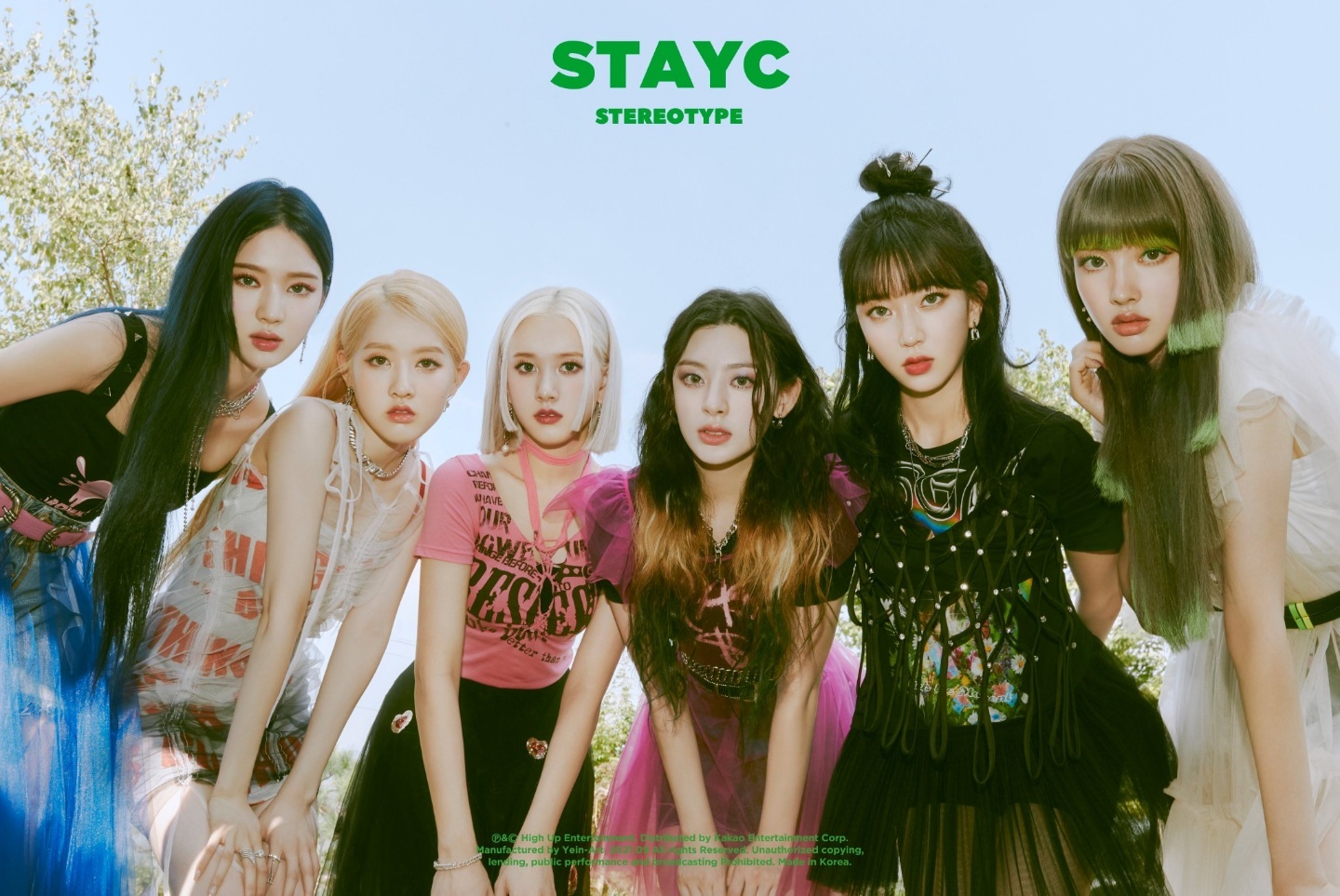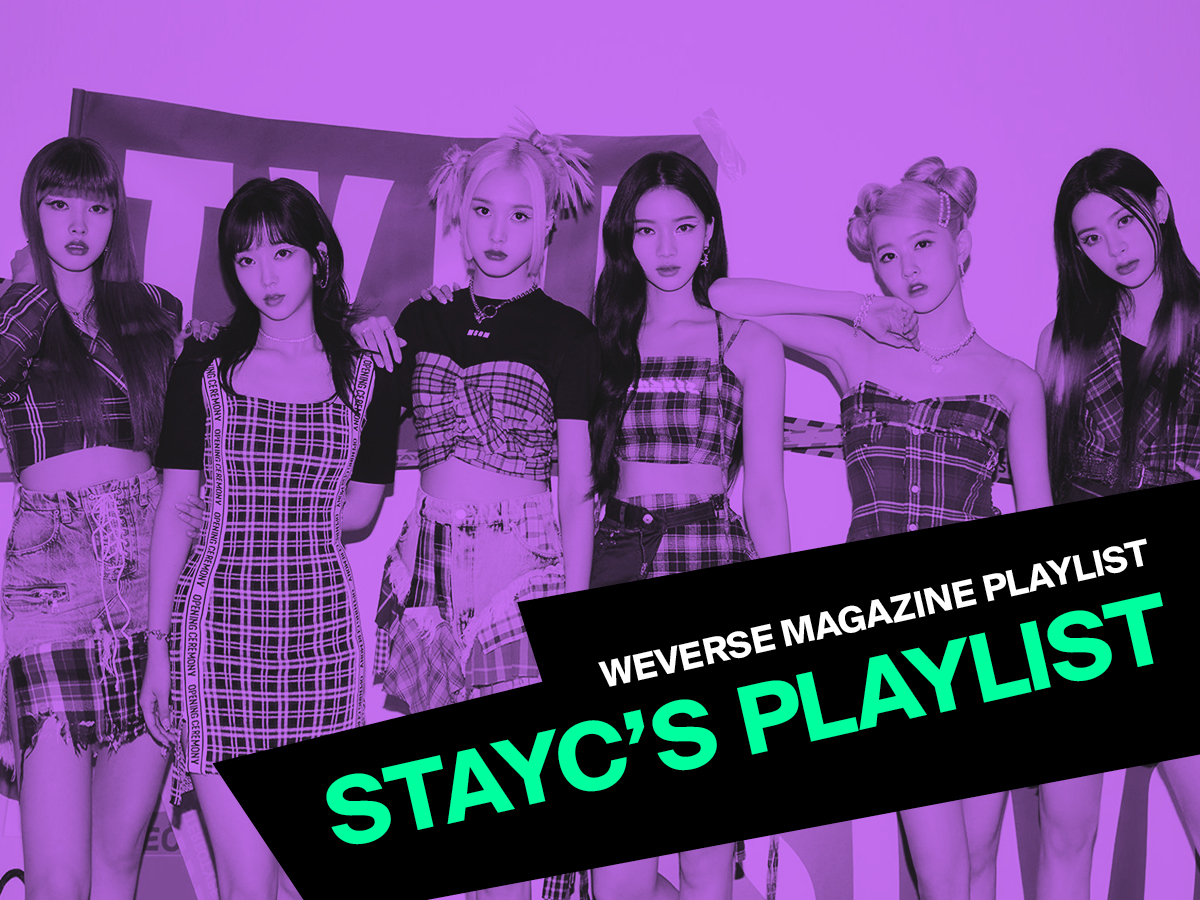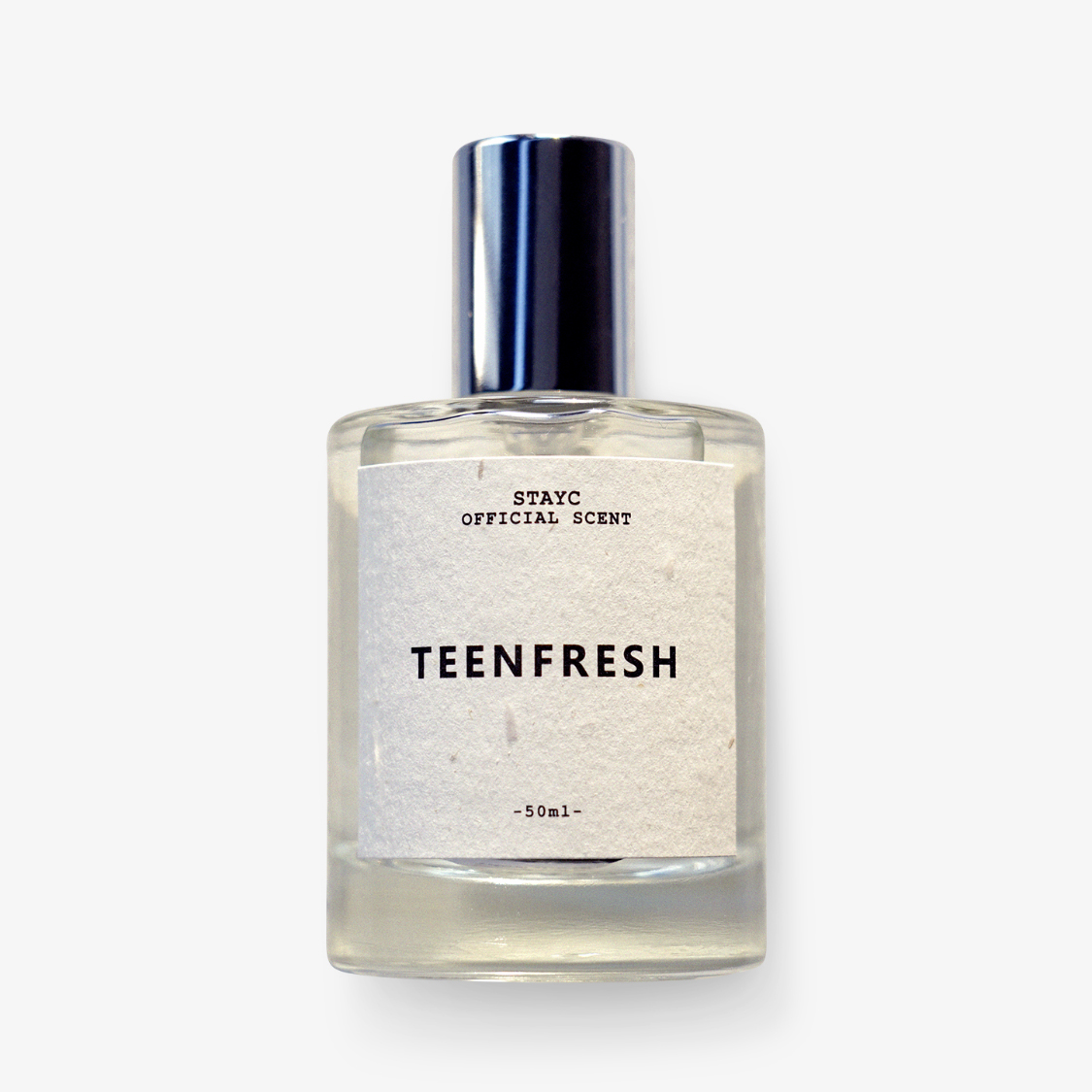
FEATURE
Today’s “K-TEEN” seen through STAYC X Gen Z
Star to a Young Culture
2021.11.01
Credit
Article. Minji Oh
Photo Credit. Highup Entertainment
STAYC has brought back the school aesthetic seen in teen movies of the early 2000s for their “STEREOTYPE” performance, complete with plaid outfits, headbands, and hair clips—all the trappings of the preppy look. “People always say Yoon is like a 2D character, so we took a sleeveless top that fits in with Y2K fashion to emphasize her long, slender limbs and paired it with bold accessories for her neck and wrists, while for J we did a 180 or put her in a vest to give her a more modern look,” Lee Soo-ha, production team head at STAYC's label, High Up Entertainment, explained. They arranged the costumes for the performance such that they could assign “each member their own student feel or character in line with the story.” Y2K fashion is a recent trend that calls back to the individualistic, confident protagonists in teen movies of yesteryear. In “STEREOTYPE,” STAYC adopted the Korean version of the teen movie image, wearing costumes to whet the curiosity people in their teens and 20s who are eager to see what fashion for the movie characters of the times looked like while simultaneously giving each member a chance to show off their own persona.
Lee says STAYC’s style was the result of choosing “to express their personal character and values using the independence that comes from within as a starting point and to show more respect for diversity than anybody else.” Yoon, for example, looked to game characters to try a number of hairstyles, including twinkling hair extensions, highlights, Pippi Longstocking braids, double buns, and a three-layered cut. According to the idol, this process was the start of finding her own style. “It’s scary and it’s fun,” Yoon said. “Seeing as they’re styles I never tried before, sometimes I think, Can I pull this off? But other times I think, This will really suit me!”—a choice between finding your own individuality and what others would call your safe choice. While Yoon’s style is the most experimental among the members of STAYC, the others are simply being themselves. For example, ISA didn’t use concealer on her line of freckles, nor did J on the one on her cheek, while they varied the color of their eye makeup and amount of eyeliner to bring out their uniquely characteristic, visibly deep-set eyes.
The components of STAYC’s album show their focus on emphasizing the self, others and sense of individuality as well as a tolerance toward others in greater detail. Jung Heera, a member of High Up’s marketing team, revealed that, “because COVID-19 has made it so that the group can’t meet their fans any time soon,” each album they release includes a scented paper “in hopes that fans will keep STAYC in their memories by scent for a long time” as well as well as to ensure that “blind fans who experience STAYC solely through the auditory elements can get a better sense of STAYC’s unique qualities through the fragrance, too.” Braille that reads “STAYC SCENT” is printed on the paper so that it can also be easily identified by touch. Moreover, each copy of STEREOTYPE includes a scratch card with two different kinds of photos on it, such as a black and white and a color photo, one where the member’s eyes are open and then one where they’re closed, or one taken from the front and then from the side. The listener can customize them by scratching the picture off like a scratch-off lottery ticket and decorate its toploader (plastic protector) with the included decoration kit to create any combination that suits their tastes. The cards were conceived in response to “the current culture around idols, where fans take the photocards that they’ve decorated or otherwise customized to their tastes with them and gather at a restaurant that one of the idols likes or a cafe holding a birthday party for them and take pictures,” Park Jihye, another member of the marketing team, explained. Fans post unboxing videos on their “fantubes” (fan-run YouTube channels) or share pictures of their photocards and decorated toploaders on Twitter. The different items included with the albums allow fans to show off their tastes and check out others’. STAYC’s albums have made it possible for more people to enjoy these activities more in depth than ever before.
The combination of styles that emphasize individuality and album design with an eye for diversity is at the very crux of STAYC’s push to be in step with modern sensibilities. The TikTok dance challenge, which invites users to copy the iconic cat kneading dance in the group’s “ASAP” choreography, went viral with over 34.6 million posts (23.9 million tagged “ASAP_challenge” and another 10.7 million under “ASAPCHALLENGE”). “I’m not just enjoying it as it is,” Sieun said, reflecting on the dance challenge, “but doing this iconic dance with other artists and making changes to the same song to make many different versions of it and then filming them, and I think that makes the song we’re promoting right now all the more enjoyable.” J, who is in high school, describes how comfortable her classmates are with technology, saying there’s “lots of people in my classes who use a laptop or an iPad instead of a paper notebook and tons of people who spend their breaktime using TikTok or making a vlog on their YouTube.” It's typical for those who are a part of the generation of digital natives like STAYC to express themselves publicly to countless people. But their generation isn’t only intent on emphasizing how different they are from others; on the contrary, because they live under the watchful gaze of other people, they also tend to be very interested in the issues that affect them. For example, STAYC used their STAYC challenge to promote environmental awareness by eating healthy and reducing waste. ISA suggests making vegan food part of a healthy diet, gives a definition of veganism from the Internet and checks out a nearby vegan bakery to show some of her favorite items on the menu. “Just a few years ago, even I found vegetarianism and veganism unfamiliar and difficult, but more and more people were becoming vegan to be socially responsible, so I tried it out of curiosity,” she said, explaining why she made the video. “When I tried it myself, I realized it helps the environment in many ways, and most importantly I could feel myself becoming healthier, so I tried to help more people become familiar with the vegan lifestyle through different media in hopes of us all becoming healthier together.”
Their challenge to reduce waste was later moved to the YouTube channel MMTG in a video where they showed off tumblers and bamboo toothbrushes, proving the environmental movement is ongoing and sustainable. When Seeun was jokingly asked in the video if it’s all just for show, she answered that they “have to show something like that” to ultimately benefit the environment. “There are many alternatives to disposal products you can use now, but people who aren’t very interested don’t know about them,” Sieun said. “So we wanted to make the environment a little healthier, even just a little bit, by showing us using them and letting people known about them.” Environmental movements and ethical consumption principles, like zero waste, zero plastic, challenges to use eco-friendly packaging and veganism have long been suggested as ways to solve some of the various problems the world faces, but when such an idol group as focused on individuality as STAYC takes to the same stage as these socially responsible practices, it really shows the character of Generation Z, the people who are currently in their teens and 20s. Self-expression is important to Gen Z, and they are quite skilled at doing so through social media. That’s exactly why getting a reaction over social media is so important to them and why they pay attention to the issues they feel are important to them. It seems clear, then, that this is what STAYC is trying to convey in their recently released STEREOTYPE. In the trailer for the album, some of the members don’t even show their faces, and at the end the members, clad in dresses, run forward with the camera at their backs. In the lyrics to the title track, as well, they sing of being “still afraid even I look fancy,” but vow to try and be themselves and not pay attention to other peoples’ stereotypical views of them. The song goes on to encourage listeners to have respect for their own individuality as well as the diversity of others because it will eventually bring them to accept every part of themselves just the way they are—in other words, the ability not just to declare oneself as an individual, but to recognize that everyone is different. STAYC is slowly creating their identity the same way young people these days do—a way that may seem typical and laid back, but is actually entirely new.
The emphasis that the members of STAYC place on their efforts is largely in line with the attitudes held by their contemporaries in the idol scene. Yoon consistently juxtaposes talent with effort, as when she wanted the author of a short biography about her to “change” the words “talented vocalist” to “hard worker” on an episode of 1theK Originals’ IDDP to emphasize that her musical achievements have been the result of her efforts, or how, if someone were to be off-key an entire concert, she would admit that it’s from a lack of practice, but that it’s still possible to miss one note despite all their effort, so she said, “We all sing well.” When asked about the way they chase after their goals, Sumin explained that she thinks “it’s because we have confidence in ourselves but at the same time we have a clear view of where we feel we’re lacking and the other things we each want to improve upon. So I always work toward improving myself until I feel satisfied.” Seeun adds, “We decided to show more of that side of us in hopes that the people who watch us would feel confident and courageous, too.” It’s hard to predict how someone will go about achieving success in this era where everyone can show themselves off. To that end, the more effort is seen as the key to getting nearer to success and the more it’s understood to be a means to prove oneself. With all their recording, choreography and practicing, STAYC exudes the workhorse brand of carpe diem captured by the slang phrase “god-tier life.” Now their talent and their efforts have become part of the group’s brand—which one need only look at their STEREOTYPE a cappella highlight medley to see.
In the “Lives of Idols: Trainees” and “Lives of Idols: Final Assessment” episodes of YouTube’s K-Pop Evolution series, the members of STAYC are frank about the complexity of their emotions, coming clean about training slumps, the mixed feelings they had prior to their debut and developing complexes surrounding their diet. In order to survive the experience, ISA said, “When my body wouldn’t do what I wanted it to or I felt bad, I told myself my skill level would improve if I could just do a good job with that one thing.” This is another trait that separates present-day idols from their forerunners: an openness about their struggles prior to debut and how they’re getting along at the moment. Given the group operates under a concept they call “teen fresh,” this stance calls to mind the very definition of teen life that STAYC and their label have their eyes on. “I think we have to have healthy bodies and minds first so that we can convey the same to the public,” Sieun said. “That’s why we try to keep positive among ourselves and enjoy life by managing our stress and pursuing our own personal hobbies and leisure time for the sake of our mental health.” Being honest with yourself, uncovering your individuality, and living a life of constant improvement to present your freshest self: For those who hope to grow along with STAYC and come to understand the new generation by watching them, the group is like a kind of buoy, undulating along on the waves of a new era, guiding them to a world where it’s never wrong to be different and showing the way to those who are cast adrift or run aground in the ebb and flow of an ever-changing society.
Copyright © Weverse Magazine. All rights reserved.
Unauthorized reproduction and distribution prohibited.
Unauthorized reproduction and distribution prohibited.
Read More
- STAYC’s playlist2021.09.27


